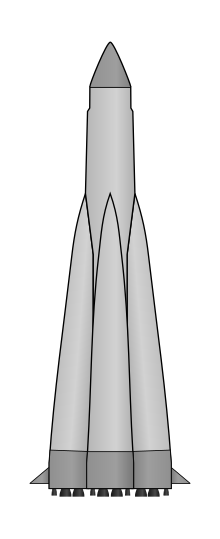Polyot (rocket)
Appearance
This article needs additional citations for verification. (December 2009) |
 Polyot rocket | |
| Function | Interim carrier rocket |
|---|---|
| Manufacturer | OKB-1 |
| Country of origin | Soviet Union |
| Size | |
| Height | 30m (98ft) |
| Diameter | 2.99m (9.8ft) |
| Mass | 277,000kg (610,000lb) |
| Stages | 1 |
| Capacity | |
| Payload to LEO | 1,400kg (3,000lb) |
| Associated rockets | |
| Family | R-7 |
| Launch history | |
| Status | Retired |
| Launch sites | LC-31, Baikonur |
| Total launches | 2 |
| Success(es) | 2 |
| First flight | 1 November 1963 |
| Last flight | 12 April 1964 |
| Boosters | |
| No. boosters | 4 |
| Engines | 16 RD-107-8D74K |
| Thrust | 995.3kN (223,752lbf) |
| Specific impulse | 257 sec |
| Burn time | 119 seconds |
| Propellant | RP-1/LOX |
| First stage | |
| Engines | 1 RD-0108 |
| Thrust | 294kN (66,093lbf) |
| Specific impulse | 330 sec |
| Burn time | 240 seconds |
| Propellant | RP-1/LOX |
The Polyot (Also known as Sputnik, GRAU index 11A59) was an interim orbital carrier rocket, built to test ASAT spacecraft. It was required as a stopgap after the cancellation of the UR-200 programme, but before the Tsyklon could enter service. Only two were ever launched, the first on 1 November 1963, and the last on 12 April 1964. Both of these flights were successful.
The rocket consisted of a core stage, and four boosters, which were taken from a Voskhod 11A57 rocket. It was capable of delivering a 1,400 kg payload into a 300 km by 59° Low Earth orbit.
It is a member of the R-7 family.
See also
Comparable rockets
Related developments
Associated spacecraft
External links

